Aminahassan001
On this page, you find all documents, package deals, and flashcards offered by seller AMINAHASSAN001.
- 456
- 0
- 19
Community
- Followers
- Following
475 items

ACLS Precourse Solution.
ACLS Precourse Solution.Lesson1: system of care. Which quality improvement component of systems of care best describes the capture and review of data related to resuscitation education, processes, and outcomes? -ANSWER Measurement Lesson1: system of care.Which one of the following is an interdependent component of systems of care? -ANSWER Structure Lesson2: Science of Resuscitation.What is an effect of excessive ventilation? -ANSWER decreased CO Lesson2: Science of Resuscitation. Which ...
- Package deal
- Exam (elaborations)
- • 4 pages •
ACLS Precourse Solution.Lesson1: system of care. Which quality improvement component of systems of care best describes the capture and review of data related to resuscitation education, processes, and outcomes? -ANSWER Measurement Lesson1: system of care.Which one of the following is an interdependent component of systems of care? -ANSWER Structure Lesson2: Science of Resuscitation.What is an effect of excessive ventilation? -ANSWER decreased CO Lesson2: Science of Resuscitation. Which ...
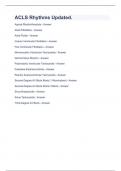
ACLS Rhythms Updated.
ACLS Rhythms Updated.Agonal Rhythm/Asystole - Answer Atrial Fibrillation - Answer Atrial Flutter - Answer Coarse Ventricular Fibrillation - Answer Fine Ventricular Fibrillation - Answer Monomorphic Ventricular Tachycardia - Answer Normal Sinus Rhythm - Answer Polymorphic Ventricular Tachycardia - Answer Pulseless Electrical Activity - Answer Reentry Supraventricular Tachycardia - Answer Second-Degree AV Block Moritz 1 Wenchebach - Answer Second-Degree AV Block Mo...
- Package deal
- Exam (elaborations)
- • 1 pages •
ACLS Rhythms Updated.Agonal Rhythm/Asystole - Answer Atrial Fibrillation - Answer Atrial Flutter - Answer Coarse Ventricular Fibrillation - Answer Fine Ventricular Fibrillation - Answer Monomorphic Ventricular Tachycardia - Answer Normal Sinus Rhythm - Answer Polymorphic Ventricular Tachycardia - Answer Pulseless Electrical Activity - Answer Reentry Supraventricular Tachycardia - Answer Second-Degree AV Block Moritz 1 Wenchebach - Answer Second-Degree AV Block Mo...
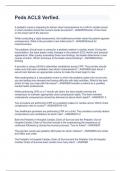
Peds ACLS Verfied.
Peds ACLS Verfied.A pediatric nurse is preparing to deliver chest compressions to a child in cardiac arrest. In which location should the nurse's hands be placed? - ANSWERCenter of the chest on the lower half of the sternum While conducting a rapid assessment, the healthcare provider notes the patient appears unresponsive. What is the provider's next initial action? - ANSWERcheck for responsiveness The pediatric clinical team is caring for a pediatric patient in cardiac arrest. During th...
- Package deal
- Exam (elaborations)
- • 11 pages •
-
ACLS Exams • By AMINAHASSAN001
Peds ACLS Verfied.A pediatric nurse is preparing to deliver chest compressions to a child in cardiac arrest. In which location should the nurse's hands be placed? - ANSWERCenter of the chest on the lower half of the sternum While conducting a rapid assessment, the healthcare provider notes the patient appears unresponsive. What is the provider's next initial action? - ANSWERcheck for responsiveness The pediatric clinical team is caring for a pediatric patient in cardiac arrest. During th...
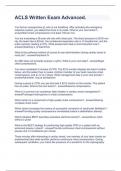
ACLS Written Exam Advanced.
ACLS Written Exam Advanced.You find an unresponsive pt. who is not breathing. After activating the emergency response system, you determine there is no pulse. What is your next action? - answerStart chest compressions of at least 100 per min. You are evaluating a 58-year-old man with chest pain. The blood pressure is 92/50 mm Hg, the heart rate is 92/min, the nonlabored respiratory rate is 14 breaths/min, and the pulse oximetry reading is 97%. What assessment step is most important now? - ans...
- Package deal
- Exam (elaborations)
- • 12 pages •
-
ACLS Exams • By AMINAHASSAN001
ACLS Written Exam Advanced.You find an unresponsive pt. who is not breathing. After activating the emergency response system, you determine there is no pulse. What is your next action? - answerStart chest compressions of at least 100 per min. You are evaluating a 58-year-old man with chest pain. The blood pressure is 92/50 mm Hg, the heart rate is 92/min, the nonlabored respiratory rate is 14 breaths/min, and the pulse oximetry reading is 97%. What assessment step is most important now? - ans...

ACLS Study Guide
ACLS Study Guide A 68-year-old woman presents with light-headedness, nausea, and chest discomfort. Your assessment finds her awake and responsive but ill-appearing, pale, and goodly disphorttie. Her radial is weak, thready, and fast. You are unable to obtain a blood pressure. She has no obvious dependent edema, and her neck veins are flat. Her lung sounds are equal, with moderate rales present bilaterally. The cardiac monitor shows the rhythm seen here. After your initial assessment of this ...
- Package deal
- Exam (elaborations)
- • 6 pages •
-
ACLS Exams • By AMINAHASSAN001
ACLS Study Guide A 68-year-old woman presents with light-headedness, nausea, and chest discomfort. Your assessment finds her awake and responsive but ill-appearing, pale, and goodly disphorttie. Her radial is weak, thready, and fast. You are unable to obtain a blood pressure. She has no obvious dependent edema, and her neck veins are flat. Her lung sounds are equal, with moderate rales present bilaterally. The cardiac monitor shows the rhythm seen here. After your initial assessment of this ...
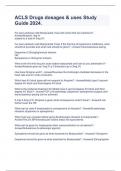
ACLS Drugs dosages & uses Study Guide 2024.
ACLS Drugs dosages & uses Study Guide 20For poor perfusion with Bradycardia Treat with which first line treatment? - AnswerAtropine 1mg IV (repeat to a total of 3mg IV) For poor perfusion with Bradycardia Treat, if the first line of treatment is ineffective, what should be provided and what med should be given? - AnswerTranscutaneous pacing Dopamine 5-20mcg/kg/minute infusion OR Epinephrine 2-10mcg/min infusion What is the first line drug for acute stable bradycardia and how do you ...
- Package deal
- Exam (elaborations)
- • 9 pages •
-
ACLS Exams • By AMINAHASSAN001
ACLS Drugs dosages & uses Study Guide 20For poor perfusion with Bradycardia Treat with which first line treatment? - AnswerAtropine 1mg IV (repeat to a total of 3mg IV) For poor perfusion with Bradycardia Treat, if the first line of treatment is ineffective, what should be provided and what med should be given? - AnswerTranscutaneous pacing Dopamine 5-20mcg/kg/minute infusion OR Epinephrine 2-10mcg/min infusion What is the first line drug for acute stable bradycardia and how do you ...
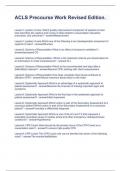
ACLS Precourse Work Revised Edition.
ACLS Precourse Work Revised Edition.Lesson1: system of care. Which quality improvement component of systems of care best describes the capture and review of data related to resuscitation education, processes, and outcomes? - answerMeasurement Lesson1: system of care.Which one of the following is an interdependent component of systems of care? - answerStructure Lesson2: Science of Resuscitation.What is an effect of excessive ventilation? - answerdecreased CO Lesson2: Science of Resuscita...
- Package deal
- Exam (elaborations)
- • 4 pages •
-
ACLS Exams • By AMINAHASSAN001
ACLS Precourse Work Revised Edition.Lesson1: system of care. Which quality improvement component of systems of care best describes the capture and review of data related to resuscitation education, processes, and outcomes? - answerMeasurement Lesson1: system of care.Which one of the following is an interdependent component of systems of care? - answerStructure Lesson2: Science of Resuscitation.What is an effect of excessive ventilation? - answerdecreased CO Lesson2: Science of Resuscita...

ACLS Megacode Questions with 100%correct Answers.
ACLS Megacode Questions with 100%correct Answfor several hours. The assessment is as follows: SKIN: Hydrated, pale, warm and dry CVS: Strong peripheral pulses and a BP of 125/80 CNS: Fully intact RESP: RR is 22, no resp. difficulties, lungs CTA You place o2 at 2L by NC on the patient and start an IV. The monitor shows a narrow complex SVT (160). What is your next intervention? - Answerattempt vagal maneuvers You have performed vagal maneuvers. The patient has shows no change on ...
- Package deal
- Exam (elaborations)
- • 2 pages •
-
ACLS Exams • By AMINAHASSAN001
ACLS Megacode Questions with 100%correct Answfor several hours. The assessment is as follows: SKIN: Hydrated, pale, warm and dry CVS: Strong peripheral pulses and a BP of 125/80 CNS: Fully intact RESP: RR is 22, no resp. difficulties, lungs CTA You place o2 at 2L by NC on the patient and start an IV. The monitor shows a narrow complex SVT (160). What is your next intervention? - Answerattempt vagal maneuvers You have performed vagal maneuvers. The patient has shows no change on ...
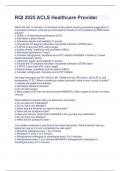
RQI 2025 ACLS Healthcare Provider
RQI 2025 ACLS Healthcare ProviderAfter 2 minutes, the team pauses CPR for a rhythm check. What rhythm is now being demonstrated by the patient? o Ventricular tachycardia o Pulseless electric activity o Ventricular fibrillation o Asystole ANSWER o Ventricular tachycardia The patient is showing persistent pulseless ventricular tachycardia. What actions need to be completed next by the team? Place in the correct order o Shock immediately o Resume CPR o Administer epinephrine 1mg IV o Con...
- Package deal
- Exam (elaborations)
- • 6 pages •
-
ACLS Exams • By AMINAHASSAN001
RQI 2025 ACLS Healthcare ProviderAfter 2 minutes, the team pauses CPR for a rhythm check. What rhythm is now being demonstrated by the patient? o Ventricular tachycardia o Pulseless electric activity o Ventricular fibrillation o Asystole ANSWER o Ventricular tachycardia The patient is showing persistent pulseless ventricular tachycardia. What actions need to be completed next by the team? Place in the correct order o Shock immediately o Resume CPR o Administer epinephrine 1mg IV o Con...
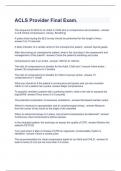
ACLS Provider Final Exam.
ACLS Provider Final Exam.The sequence for BLS for an Adult or Child who is unresponsive and pulseless. -answer C-A-B (Chest compressions, Airway, Breathing) A pulse check during the BLS survey should be performed for this length of time. -answer 5 to 10 seconds A likely indicator of a cardiac arrest in the unresponsive patient. -answer Agonal gasps After discovering an unresponsive patient, what is the next step in the assessment and management of this patient? -answer Check the patient...
- Package deal
- Exam (elaborations)
- • 8 pages •
-
ACLS Exams • By AMINAHASSAN001
ACLS Provider Final Exam.The sequence for BLS for an Adult or Child who is unresponsive and pulseless. -answer C-A-B (Chest compressions, Airway, Breathing) A pulse check during the BLS survey should be performed for this length of time. -answer 5 to 10 seconds A likely indicator of a cardiac arrest in the unresponsive patient. -answer Agonal gasps After discovering an unresponsive patient, what is the next step in the assessment and management of this patient? -answer Check the patient...
